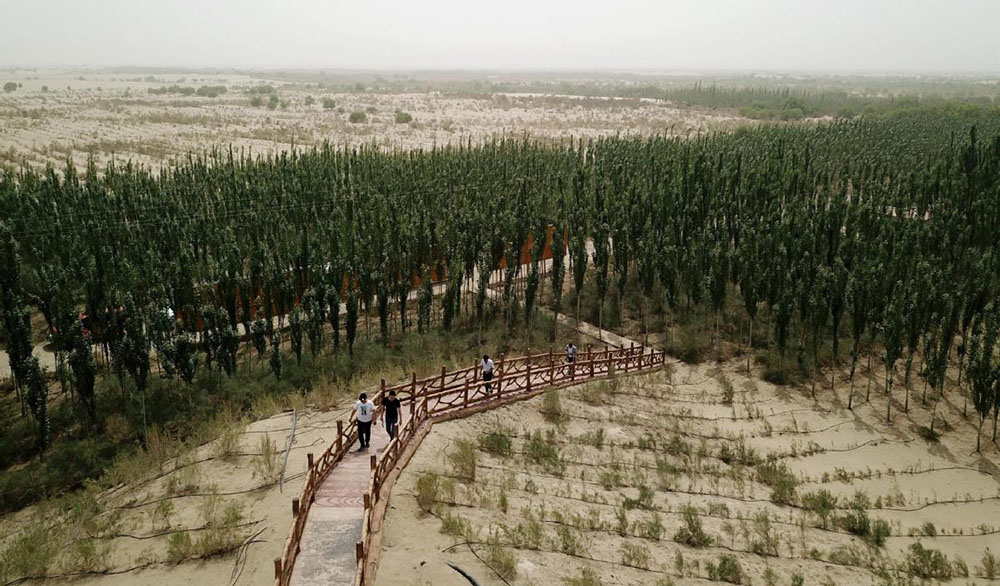Written by: Mahnoor Fatima
Posted on: June 25, 2020 | 
Visitors at the Hefei Wetland Forest Park in Anhui Province
The National Forest Protection Project (NFPP) is one of the world’s largest ecological rehabilitation projects. It is a major initiative taken by the Government of China to mitigate some of the environmental damage that occurs through rapid economic advancements, by implementing strict yet creative policies on large scale conservation. It has been massively successful and has been working to meet international standards for conservation, such as those carried out by the World Bank.
China covers some of the most diverse climates in the world, and about 10% of all species on Earth live there. According to reports from the National Forestry and Grassland Administration, in 2016 China’s natural forest reached 1.8 billion hectares, covering 212 natural types of forest. Unfortunately, due to population growth, economic development and policy failures, the late 90’s saw a sharp drop in biodiversity and soil erosion as well as a rise in desertification.
Severe floods hit areas of North-West China as a direct result of deforestation and soil erosion in the area.The NFPP began in 1998, initially focusing on tree plantation in state-owned forests along the Yangtze River, Yellow River, and Inner Mongolia. But in light of the rapid decline in biodiversity and the impending threats of natural disasters, the Government of China pledged to expand conservation efforts beyond tree plantation, through rigorous conservation laws and programs. These included the establishment of protected areas, replanting of trees, animal rescue centers, and more.
So far, this initiative has been incredibly successful for the environment, the economy, and society. It covers the forest bureaus of 17 provinces, 12 forest enterprises, and 4 forest farms in Xinjiang. Due to conservation efforts, the forest volume rose by over 1.109 billion cubic meters and over 650,000 forestry workers. China is well on its way to fulfill its pledge of adding 4.5 billion cubic meters of forests by 2030.

A man-made forest in Makit county, Kashgar, Xinjiang Uygur Autonomous Region (ZHANG GUIGUI / FOR CHINA DAILY)
One of the reasons for its wide-scale success is the fact that it is community-driven and participatory. The state-owned forestry bureaus in the most sensitive protected areas receive a subsidy of 15 million yuan annually to sustain their operation. NFPP relies heavily on local government participation, which has been beneficial in two ways. On one hand, the local governments are given a lot of responsibility and feel ownership of the project, and on the other, the national government is more effective in poverty alleviation programs.
For example, the region of Xinjiang has seen considerable forestation efforts. The once small oasis around the vast Taklimakan desert era has now increased in size. This is thanks to the efforts of generations of workers, and scientific innovations in forestry and water management. Rare animals like the Tarim Red Deer of the Tianshan scenic area have also increased in numbers due to strict wildlife conservation efforts and initiatives like NFPP.
Then there are more challenging aspects like updating industries, which cause environmental damage. For instance, a considerable amount of China’s economy comes from wood and wood-based products like paper. Since logging within natural forests has been completely banned, there have been significant changes to the logging industry. The biggest challenge is to transition those who were participating in unsustainable forest practices to more environmentally friendly jobs, like working with NFPP. However, time and close monitoring will confirm how successful these operations will be in the long run.
Such nationwide forestation initiatives serve as interesting blueprints for other countries to take environmental issues seriously. While this is a long-term plan, it is already showing signs of progress in terms of its socio-economic benefits. In light of the challenge of climate change crisis, it is important that a country as large as China, which is also home to the largest population in the world is making active efforts to save its forest and wildlife.
You may also like: